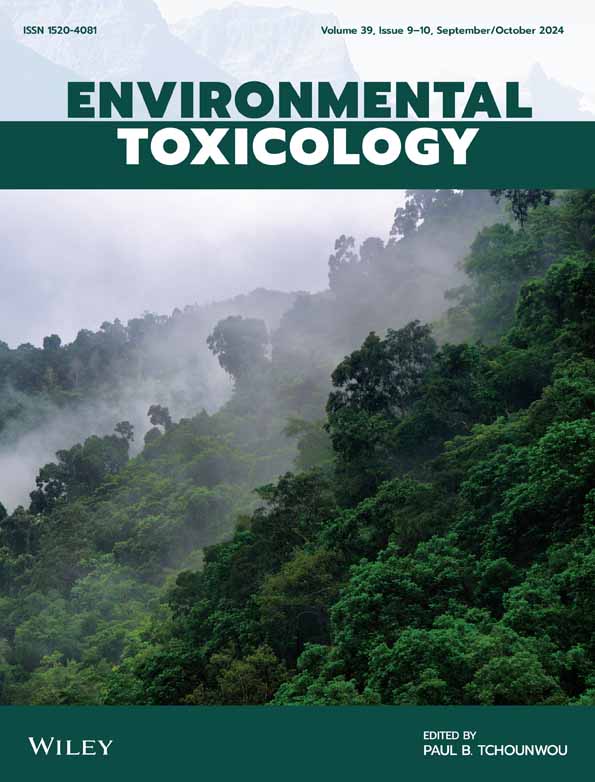利用多种生物标志物评价对羟基苯甲酸丁酯在土壤生物中的生态毒理学作用。
IF 3.2
3区 医学
Q2 ENVIRONMENTAL SCIENCES
引用次数: 0
摘要
对羟基苯甲酸丁酯(BuP)经常污染世界各地的土壤,主要是通过将污水污泥掺入耕地,将废水用于灌溉,以及浸出被污染的土壤。然而,关于该对羟基苯甲酸酯对土壤生物的生态毒理学效应的研究很少。在10、50、100和500 ng/L浓度下,研究了BuP对胡萝卜、洋葱和黄瓜种子、洋葱球茎根和蚯蚓的生态毒性。在根分生组织中,四种浓度的BuP诱导脂质过氧化,提高超氧自由基水平,从而抑制细胞分裂和有丝分裂纺锤体改变,显著降低根在种子和鳞茎中的生长。在动物实验中,10、50、100和500 ng/L的BuP分别使蚯蚓逃避人工土壤的80%、80%、70%和90%。此外,这种对羟基苯甲酸酯在接触14天后不会导致蚯蚓死亡。然而,所有浓度都增加了细胞中超氧化物和羟基自由基的产生,并引起脂质过氧化。因此,增加接触这种化合物会对生态功能产生负面影响和/或导致这些动物死亡。因此,BuP的反复污染会对土壤质量产生负面影响,对农业生产力和环境构成风险。本研究在环境相关浓度下植物BuP的生态毒理学评价和蚯蚓的行为和氧化应激研究方面是开创性的。本文章由计算机程序翻译,如有差异,请以英文原文为准。
Ecotoxicological Evaluation of the Antimicrobial Butylparaben in Edaphic Organisms Using Multiple Biomarkers.
Butylparaben (BuP) recurrently contaminates soils worldwide, mainly by incorporating sewage sludge into cultivated areas, using wastewater in irrigation, and leaching contaminated soils. However, there are few studies on the ecotoxicological effects of this paraben on edaphic organisms. The ecotoxicity of BuP was evaluated in seeds of Daucus carota, Allium cepa, and Cucumis sativus, in the roots of A. cepa bulbs, and in Eisenia fetida earthworms, at concentrations of 10, 50, 100, and 500 ng/L. In root meristems, the four concentrations of BuP induced lipid peroxidation and raised the levels of superoxide radicals, which triggered inhibition of cell division and mitotic spindle alteration, significantly reducing the growth of roots in seeds and bulbs. In animals, BuP at 10, 50, 100, and 500 ng/L caused 80%, 80%, 70%, and 90% evasion of earthworms from artificial soil, respectively. In addition, this paraben did not cause mortality in earthworms after 14 days of exposure. However, all concentrations increased the production of superoxide and hydroxyl radicals in cells and caused lipid peroxidation. Thus, increased exposure to this compound can affect the ecological functions negatively and/or cause the death of these animals. Therefore, recurrent contamination with BuP can negatively impact soil quality, posing a risk to agricultural productivity and the environment. This study is a pioneer in the ecotoxicological evaluation of BuP in plants at environmentally relevant concentrations and in the behavioral and oxidative stress study in earthworms.
求助全文
通过发布文献求助,成功后即可免费获取论文全文。
去求助
来源期刊

Environmental Toxicology
环境科学-毒理学
CiteScore
7.10
自引率
8.90%
发文量
261
审稿时长
4.5 months
期刊介绍:
The journal publishes in the areas of toxicity and toxicology of environmental pollutants in air, dust, sediment, soil and water, and natural toxins in the environment.Of particular interest are:
Toxic or biologically disruptive impacts of anthropogenic chemicals such as pharmaceuticals, industrial organics, agricultural chemicals, and by-products such as chlorinated compounds from water disinfection and waste incineration;
Natural toxins and their impacts;
Biotransformation and metabolism of toxigenic compounds, food chains for toxin accumulation or biodegradation;
Assays of toxicity, endocrine disruption, mutagenicity, carcinogenicity, ecosystem impact and health hazard;
Environmental and public health risk assessment, environmental guidelines, environmental policy for toxicants.
 求助内容:
求助内容: 应助结果提醒方式:
应助结果提醒方式:


